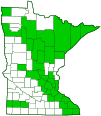Northern Cinnabar Polypore
(Trametes cinnabarina)
Conservation • Description • Habitat • Ecology • Distribution • Taxonomy
Conservation Status |
|
|||||||
| IUCN Red List | not listed |
|||||||
| NatureServe | NNR - Unranked |
|||||||
| Minnesota | not listed |
|||||||
Description |
||
Northern Cinnabar Polypore is an easily recognized bracket fungus. It is widespread and common in eastern North America but not common in Minnesota. It is found from spring to fall, alone or in groups, on dead hardwood. It is rarely found on conifers. It is saprobic, causing white rot on fallen logs. The fruiting body is a stalkless, shelf-like bracket. The bracket is nearly circular to fan-shaped or kidney-shaped, The underside is bright reddish-orange or cinnabar-red. It is similar to upperside color when fresh, but it does not fade with age. There are 2 to 4 pores per 1 ⁄32″ (1 millimeter). The flesh is reddish to yellowish-red. It is too tough to be edible. The spore print is white. |
||
Similar Species |
||
Habitat and Hosts |
||
Deciduous and mixed forests |
||
Ecology |
||
Season |
||
Spring through fall |
||
Distribution |
||||
|
Sources |
|||
| 11/18/2022 | ||||
Occurrence |
||||
Widespread but not common |
||||
Taxonomy |
|||
| Kingdom | Fungi (Fungi) | ||
| Subkingdom | Dikarya | ||
| Phylum | Basidiomycota (Basidiomycete Fungi) | ||
| Subphylum | Agaricomycotina (Higher Basidiomycetes) | ||
| Class | Agaricomycetes (Mushrooms, Bracket Fungi, Puffballs, and Allies) | ||
| Subclass | incertae sedis (uncertain placement) | ||
| Order | Polyporales (shelf fungi) | ||
| Family | Polyporaceae (bracket fungi) | ||
| Genus | Trametes | ||
In a molecular DNA study published in 2011, the authors noted that “Pycnoporus is separated from Trametes solely on the basis of the orange-red colors of the basidiocarps.” They concluded that “...all members of the trametoid clade should be classified under one single generic name (Trametes).” Pycnoporus cinnabarinus became Trametes cinnabarina. This reclassification has not been universally accepted. |
|||
Synonyms |
|||
Boletus cinnabarinus Polyporus cinnabarinus Pycnoporus cinnabarinus Trametes cinnabarinus |
|||
Common Names |
|||
Cinnabar Polypore Cinnabar-red Polypore Northern Cinnabar Polypore |
|||
Glossary
Saprobic
A term often used for saprotrophic fungi. Referring to fungi that obtain their nutrients from decayed organic matter.
Visitor Photos |
|||||
Share your photo of this fungus. |
|||||
| This button not working for you? Simply email us at info@MinnesotaSeasons.com. Attach one or more photos and, if you like, a caption. |
|||||
Luciearl |
|||||
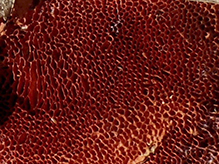 |
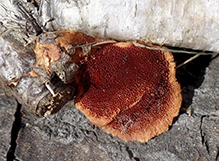 |
||||
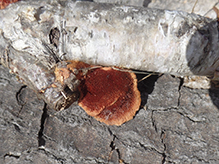 |
|||||
MinnesotaSeasons.com Photos |
|||||
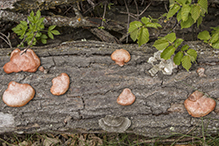 |
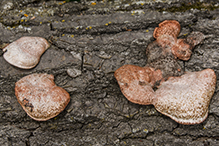 |
||||
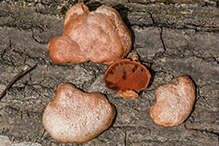 |
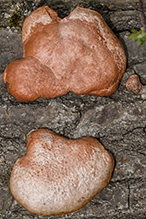 |
||||

Slideshows |
||

Visitor Videos |
|||
Share your video of this mammal. |
|||
| This button not working for you? Simply email us at info@MinnesotaSeasons.com. Attach a video, a YouTube link, or a cloud storage link. |
|||
Other Videos |
|||
| Cinnabar-red Polypore, wild mushroom RedFree100 |
|||
About
Published on Sep 30, 2012 Tough, stalkless cap with cinnabar-to orange-red pores |
|||
| Trametes cinnabarina - A Red Polypore Bracket Fungi The Roaming Gnome...Glenn Munro! VRCM/SkyWarn |
|||
About
Published on Feb 14, 2016 Red polypore bracket fungi - Ozarks region, Central Missouri - Winter. Edible, just not 5 star. Starts white grows in rosette form....and turns red. The color red is another fungi that grows on this fungus after it blanches white. Not very tasty, edibility n/a. Can give you a headache, nausea, irritate the bowels and dehydrate you....leaving you feeling like a hang over. |
|||
| Trametes cinnabarina + mysterious wood fungi BUANG88 |
|||
About
Published on Nov 25, 2017 Trametes cinnabarina + mysterious wood fungi |
|||
| Trametes cinnabarina - CRVENI RUPIČAR Nikola Lačković |
|||
About
Published on May 14, 2017 cinnabar polypore, Пикнопорус киноварно-красный, Киноварный гриб, Trametes cinnabarina, crveni rupičar, cinnabar red polypore, red polypore Trametes cinnabarina, gljiva crveni rupičar, Orange fungi Cinnabar Polypore. Music by Tomdoff: |
|||

Last Updated:
